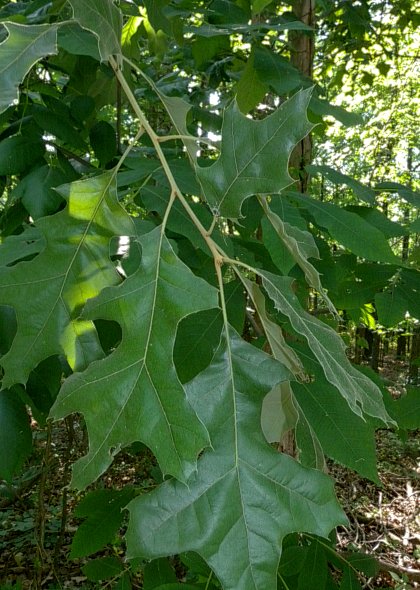
Cherrybark Oak is monoecious, forming male (staminate) and female (pistillate) flowers in separate locations on the same tree. The male flowers are produced in pendulous catkins about 3-6" long. Each male flower is very small (about 3 mm. or 1/8" across), consisting of several stamens that are partially enclosed by a ciliate calyx with multiple lobes. The central stalk of each catkin is hairy. The female flowers are produced in small clusters on a short spike less than ¾" long. Each female flower is also very small (about 3 mm. or 1/8" across), consisting of an ovoid ovary with 3 stigmata that is largely enclosed by a hairy calyx. The blooming period occurs during mid-spring for 1-2 weeks. The flowers are cross-pollinated by the wind. Afterwards, fertile female flowers develop into acorns up to 15 mm. (5/8") long that become mature the following year during the fall (2-year development cycle). Each acorn has a moderately shallow cup (extending up to one-third of its length) that is attached to the apex of the nut. The cup is minutely pubescent.
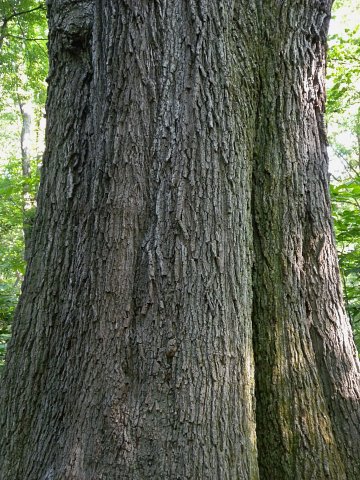
Cultivation: The preference is full sun, moist conditions, and loamy soil. Occasional flooding is tolerated during the winter and spring, otherwise standing water is harmful to the health and development of this tree. Individual trees can live up to 300 years. Acorn production begins at about the age of 25. This tree is hardy to about Zone 6 or 7.
Range & Habitat: The native Cherrybark Oak is occasional in southern Illinois, while in the rest of the state it is absent (see Distribution Map). Its range extends southward and eastward into a large area of southeastern United States. Habitats consist of bottomland woodlands, floodplain woodlands, areas along rivers and streams, and well-drained hammocks within swamps. Cherrybark Oak occurs with other moisture-loving deciduous trees, sometimes becoming co-dominant with Quercus palustris (Pin Oak). In the southeastern United States, it is sometimes cultivated as a street tree.
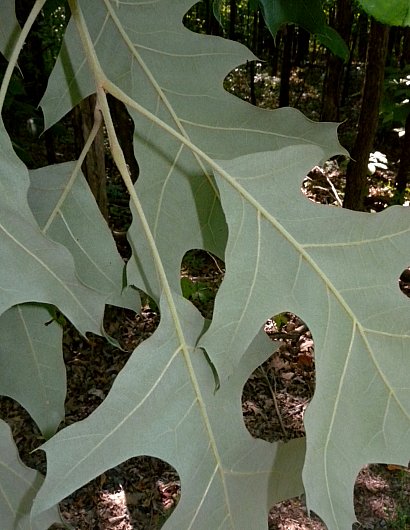
Faunal Associations: A large number of insects feed on the plant juices, foliage, wood, and other parts of Cherrybark Oak and other oak trees (Quercus spp.). These species include the larvae of metallic wood-boring beetles, larvae of long-horned beetles, larvae of bark beetles, leaf beetles, weevils, larvae of gall flies, plant bugs, stink bugs, aphids, leafhoppers, treehoppers, armored scales, mealybugs, larvae of gall wasps, larvae of sawflies, walkingsticks, larvae of Duskywing skippers (Erynnis spp.), larvae of Hairstreak butterflies (Satyrium spp.), and larvae of numerous moths. This latter group of insects includes tiger moths, ribbed cocoon-making moths, case-bearer moths, Geometer moths, leaf blotch miner moths, lappet moths, slug caterpillar moths, midget moths, owlet moths, prominent moths, giant silk moths, clear-winged moths, trumpet leaf-miner moths, and Tortrix moths; see the Beetle Table, Aphid Table, Moth Table, and Insect Table. These insects attract many kinds of insectivorous birds, such as the Scarlet Tanager, Summer Tanager, Yellow-billed Cuckoo, Tufted Titmouse, Carolina Chickadee, Prothonotary Warbler, Northern Parula, Cerulean Warbler, Yellow-throated Warbler, Blue-gray Gnatcatcher, Acadian Flycatcher, Yellow-throated Vireo, and Red-eyed Vireo (Gabbe et al., 2002).
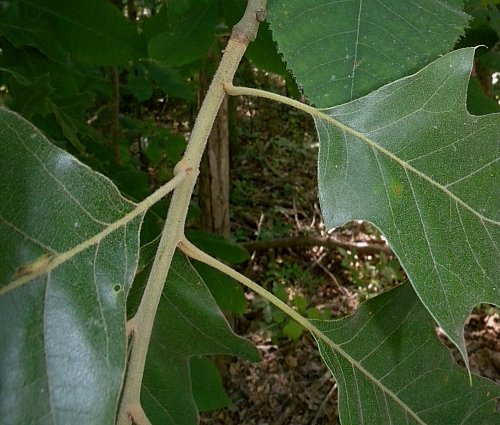
Oak trees with smaller acorns, like Cherrybark Oak, provide an important source of food for many species of birds, such as ducks, crows, blackbirds, woodpeckers, nuthatches, and upland gamebirds (see the Bird Table). Mammals that feed on acorns include the Gray Fox, White-tailed Deer, Prairie Vole, Meadow Vole, White-footed Mouse, Virginia Opossum, Raccoon, Southern Flying Squirrel, Eastern Gray Squirrel, Fox Squirrel, American Red Squirrel, Eastern Chipmunk, Muskrat (minor), and American Black Bear. White-tailed Deer and Elk also feed on the twigs and leaves, while the Cottontail Rabbit gnaws on the bark of saplings, especially during the winter, and the American Beaver feeds on the wood and bark of more mature trees that grow near bodies of water (Martin et al., 1951/1961; Hamerstrom & Blake, 1939; Whitaker, 1966; Beeman & Pelton, 1980; Schneider et al., 2006). Cherrybark Oak and other oak trees also provide protective cover for many kinds of wildlife. Birds that use these trees as sites from their nests include the Red-shouldered Hawk, Cerulean Warbler, Hooded Warbler (saplings), Blue-gray Gnatcatcher, Eastern Wood Pewee, Yellow-throated Vireo, and Field Sparrow (saplings); see Dijak et al. (1990), Newell & Rodewald (2011), Bielefeldt & Rosenfeld (2001), and Best (1978). The Silver-haired Bat, Evening Bat, Big Brown Bat, Hoary Bat, Little Brown Bat, Tricolored Bat, and Northern Long-eared Bat often select these trees as daytime roost sites and sites for maternity colonies (Perry et al., 2010; Perry & Thill, 2008; Swier, 2003; Baerwald et al., 2012; Veilleux et al., 2003; Carter, 2003).
Photographic Location: A bottomland woodland at the Heron Pond Nature Preserve in southern Illinois.
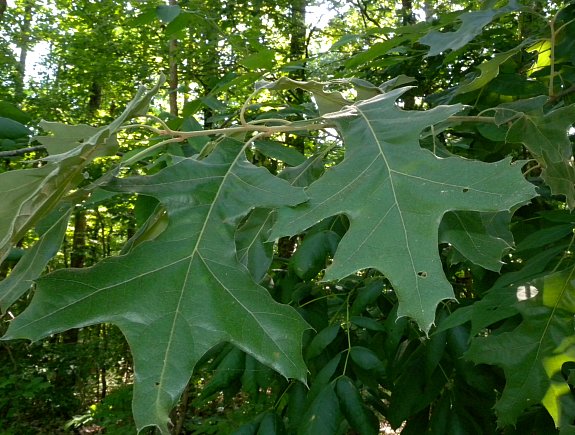
Comments: Cherrybark Oak has often been regarded as a variety of Spanish Oak (Quercus falcata), Quercus falcata pagodaefolia, but it is now considered a distinct species of oak. These two oaks can be distinguished primarily by the appearance of their leaves: Spanish Oak has leaves with narrow rounded bases (rather than wedge-shaped bases) and its lateral lobes often have simple acute tips because they are less likely to be divided into shallow secondary lobes. This latter oak also prefers drier habitats than Cherrybark Oak. With the exception of the Spanish Oak, Cherrybark Oak can be distinguished from other Quercus spp. in the Red Oak group by the the dense fine pubescence on its leaf undersides. Other species in the Red Oak group have either glabrous undersides or their pubescence is restricted to the the junctions of major veins on their leaf undersides. The wood of Cherrybark Oak is strong, heavy, and hard; it is also relatively free from knots because of the self-pruning characteristic of this tree. As a result, the wood is highly regarded for its use in making furniture, cabinets, veneer, and interior finish. Many fungi form symbiotic relationships with the roots of oak trees (e.g., many mushrooms), promoting the health of these trees. Other fungi are parasitic on the wood, helping to return its nutrients to the ecological system. See the Fungus Table for a list of fungal species that associate with oak trees.